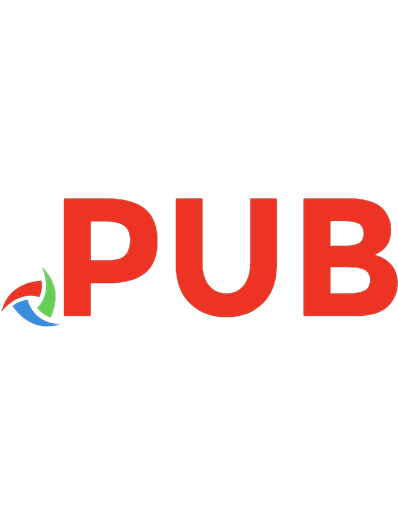Teaching Statistics: A Bag Of Tricks [2nd Edition] 0198785690, 9780198785699, 0198785704, 9780198785705, 0191827517, 9780191827518, 0191088641, 9780191088643
Students in the sciences, economics, social sciences, and medicine take an introductory statistics course. And yet stati
239 120 48MB
English Pages 421 Year 2017
Table of contents :
Cover......Page 1
Preface......Page 8
Contents......Page 10
1.2 Fitting demonstrations and examples into a course......Page 18
1.4 Why is statistics important?......Page 20
1.6 Our motivation for writing this book......Page 21
Part I Introductory probability and statistics......Page 26
2.1 Guessing ages......Page 28
2.2 Where are the cancers?......Page 30
2.3 Estimating a big number......Page 31
2.4 What’s in the news?......Page 32
2.5 Collecting data from students......Page 34
3.2 Time series......Page 36
3.3.1 Categorical and continuous variables......Page 37
3.3.2 Handedness......Page 38
3.4.1 Average soft drink consumption......Page 39
3.5 Data in more than one dimension......Page 41
3.5.1 Guessing exam scores......Page 42
3.5.2 Who opposed the Vietnam War?......Page 44
3.6 The normal distribution in one and two dimensions......Page 45
3.6.3 Scores on two exams......Page 46
3.7.2 Social and economic indexes......Page 48
3.8 Logarithmic transformations......Page 49
3.8.2 Log-linear transformation: world population......Page 50
3.8.3 Log-log transformation: metabolic rates......Page 52
4 Statistical graphics......Page 55
4.1 Guiding principles......Page 56
4.2 Lecture topics......Page 57
4.3 Assignments......Page 58
4.4 Deconstruct and reconstruct a plot......Page 60
4.5 One-minute revelation......Page 62
4.6 Turning tables......Page 63
5.1.1 Simple examples of least squares......Page 65
5.1.2 Tall people have higher incomes......Page 66
5.1.3 Logarithm of world population......Page 68
5.2.1 Correlations of body measurements......Page 70
5.2.2 Correlation and causation in observational data......Page 71
5.3.1 Mini-quizzes......Page 72
5.3.2 Exam scores, heights, and the general principle......Page 73
6.1.1 Sampling from the telephone book......Page 75
6.1.2 First digits and Benford’s law......Page 79
6.1.3 Wacky surveys......Page 81
6.1.4 An election exit poll......Page 82
6.1.6 How large is your family?......Page 83
6.2 Class projects in survey sampling......Page 84
6.2.1 The steps of the project......Page 85
6.2.2 Topics for student surveys......Page 90
6.3 How big was the crowd?......Page 93
6.4.1 An experiment that looks like a survey......Page 95
6.4.2 Randomizing the order of exam questions......Page 98
6.4.3 Taste tests......Page 99
6.5 Observational studies......Page 102
6.5.1 The Surgeon General’s report on smoking......Page 103
6.5.2 Large population studies......Page 104
6.5.3 Coaching for the SAT......Page 105
7.1 Introduction......Page 107
7.2 Assignment based on instructional packets......Page 108
7.3 Assignment where students find their own articles......Page 110
7.4 Guidelines for finding and evaluating sources......Page 113
7.6 Examples of course packets......Page 115
7.6.1 A controlled experiment: Fluids for trauma victims......Page 116
7.6.2 A sample survey: 1 in 4 youths abused, survey finds......Page 121
7.6.3 An observational study: Monster in the crib......Page 125
7.6.4 A model-based analysis: Illegal aliens......Page 129
8.2.2 Random digits via handouts......Page 134
8.3.1 Babies......Page 135
8.3.2 Real vs. fake coin flips......Page 136
8.3.3 Lotteries......Page 138
8.4.1 Lengths of baseball World Series......Page 139
8.4.3 Space shuttle failure and other rare events......Page 141
8.5.1 What’s the color on the other side of the card?......Page 142
8.5.2 Lie detectors and false positives......Page 144
8.6 You can load a die but you can’t bias a coin flip......Page 145
8.6.1 Demonstration using wooden dice......Page 146
8.6.2 Sporting events and quantitative literacy......Page 148
8.6.3 Physical explanation......Page 149
9.1 Weighing a “random” sample......Page 151
9.2.1 Where are the missing girls?......Page 152
9.2.2 Real-time gambler’s ruin......Page 153
9.3.1 Biases in age guessing......Page 154
9.3.3 Land or water?......Page 155
9.3.4 Poll differentials: a discrete distribution......Page 156
9.4.1 Coverage of confidence intervals......Page 157
9.5 Hypothesis testing: z, t, and χ2 tests......Page 159
9.5.1 Hypothesis tests from confidence intervals......Page 160
9.5.2 Binomial model: sampling from the phone book......Page 161
9.5.5 Length of baseball World Series......Page 162
9.6.1 How good is your memory?......Page 163
9.6.2 How common is your name?......Page 164
9.7.2 Do-it-yourself data dredging......Page 165
9.7.3 Praying for your health......Page 166
10.1.2 Multiple regression......Page 168
10.1.3 Regression with interactions......Page 170
10.1.4 Transformations......Page 171
10.2.2 Measuring the reliability of exam questions......Page 172
10.3 A nonlinear model for golf putting......Page 173
10.3.2 Constructing a probability model......Page 174
10.3.3 Checking the fit of the model to the data......Page 175
10.4 Pythagoras goes linear......Page 177
11.1.2 Misinformation......Page 179
11.1.4 Arbitrary comparisons or data dredging......Page 181
11.2.1 Distinguishing from other sorts of bias......Page 183
11.2.3 Avoiding over-skepticism......Page 185
11.3.1 Classroom discussion......Page 186
11.5.1 Cutting corners in a medical study......Page 188
11.5.2 Searching for statistical significance......Page 189
11.5.4 How important is blindness?......Page 190
11.5.5 Use of information in statistical inferences......Page 191
Part II Putting it all together
......Page 194
12.1.2 Advance planning......Page 196
12.1.4 Common mistakes......Page 197
12.2.1 Setting up effective demonstrations......Page 200
12.2.2 Promoting discussion......Page 201
12.2.4 Fostering group work......Page 202
12.3 Tricks for the large lecture......Page 204
12.5 Projects......Page 207
12.5.1 Monitoring progress......Page 209
12.5.2 Organizing independent projects......Page 215
12.5.3 Topics for projects......Page 218
12.5.4 Statistical design and analysis......Page 221
12.6 Resources......Page 222
12.6.1 What’s in a spaghetti box?......Page 223
12.6.3 Periodicals......Page 224
12.6.5 People......Page 225
13.1 Before the semester begins......Page 226
13.3 A detailed schedule for a semester-long course......Page 227
13.4 Outline for an alternative schedule of activities......Page 235
14.1 Starting with predictions, graphs, and deterministic models......Page 238
14.2 Teaching style......Page 240
14.4 Starting an applied regression course......Page 241
14.5 How is there time to cover all the material?......Page 243
15.1 Examples of student diaries......Page 245
15.2 Using diaries in statistics classes......Page 267
16.1 Background......Page 269
16.2 Plan for a 13-week course......Page 271
Part III More advanced courses
......Page 292
17 Decision theory and Bayesian statistics......Page 294
17.1.1 How many quarters are in the jar?......Page 295
17.1.2 Utility of money......Page 298
17.1.3 Risk aversion......Page 300
17.1.4 What is the value of a life?......Page 301
17.1.5 Probabilistic answers to true–false questions......Page 302
17.1.6 Homework project: evaluating real-life forecasts......Page 303
17.1.7 Real decision problems......Page 304
17.2.1 Where are the cancers?......Page 306
17.2.2 Subjective probability intervals and calibration......Page 307
17.2.4 Where are the cancers? A simulation......Page 310
17.2.5 Hierarchical modeling and shrinkage......Page 311
18.1.1 News clippings......Page 313
18.1.3 Class survey......Page 314
18.2.1 What do random numbers look like?......Page 316
18.3 Estimation and confidence intervals......Page 317
18.5 Statistical literacy and discussion topics......Page 320
18.6.1 Analyzing data from a complex survey......Page 322
18.6.2 Research papers on complex surveys......Page 327
18.6.3 Sampling and inference in StatCity......Page 328
18.6.4 A special topic in sampling......Page 331
19.1 Setting up a probability course as a seminar......Page 332
19.2 Introductory problems......Page 333
19.2.1 Probabilities of compound events......Page 334
19.2.2 Introducing the concept of expectation......Page 335
19.3 Challenging problems......Page 336
19.4 Does the Poisson distribution fit real data?......Page 338
19.6 Examples of structured projects......Page 339
19.6.1 Fluctuations in coin tossing—arcsine laws......Page 340
19.6.2 Recurrence and transience in Markov chains......Page 342
19.7.1 Martingales......Page 344
19.7.3 Limit distributions of Markov chains......Page 345
19.7.4 Permutations......Page 346
19.8 Research papers as projects......Page 347
20 Directed projects in a mathematical statistics course......Page 349
20.2 Fitting the cases into a course......Page 350
20.2.2 Group work in class......Page 351
20.2.4 Independent projects in a seminar course......Page 352
20.3 A case study: quality control......Page 353
20.4.1 General instructions......Page 354
20.4.2 Designing the study and fitting a response surface......Page 356
21 Statistical thinking in a data science course......Page 359
21.1.2 Core paradigms......Page 360
21.2 Topics......Page 361
21.2.2 Graphics......Page 362
21.2.4 Programming concepts......Page 363
21.2.5 Text manipulation......Page 364
21.2.6 Information technologies......Page 365
21.2.7 Statistical methods......Page 366
21.4 Copy the master......Page 367
21.5 Spam filtering assignment......Page 371
21.6 Interactive visualization assignment......Page 374
Notes
......Page 378
References......Page 392
Author Index......Page 404
Subject Index
......Page 409
![Teaching Statistics: A Bag Of Tricks [2nd Edition]
0198785690, 9780198785699, 0198785704, 9780198785705, 0191827517, 9780191827518, 0191088641, 9780191088643](https://dokumen.pub/img/200x200/teaching-statistics-a-bag-of-tricks-2nd-edition-0198785690-9780198785699-0198785704-9780198785705-0191827517-9780191827518-0191088641-9780191088643.jpg)
![Teaching Statistics: A Bag of Tricks [2 ed.]
0198785704, 9780198785705](https://dokumen.pub/img/200x200/teaching-statistics-a-bag-of-tricks-2nbsped-0198785704-9780198785705.jpg)
![BUSINESS STATISTICS [Complete, Reprint 2nd edition]
9379847017, 9379847005, 9380460419, 7439040301](https://dokumen.pub/img/200x200/business-statistics-complete-reprint-2nd-edition-9379847017-9379847005-9380460419-7439040301.jpg)
![Essential Statistics, Global Edition [2nd ed.]
9781292161280, 1292161280](https://dokumen.pub/img/200x200/essential-statistics-global-edition-2nd-ed-9781292161280-1292161280.jpg)

![Nonparametric Statistics: A Step-by-Step Approach [2nd Edition]
9781118840313, 1118840313](https://dokumen.pub/img/200x200/nonparametric-statistics-a-step-by-step-approach-2nd-edition-9781118840313-1118840313.jpg)
![Excel 2019 For Marketing Statistics: A Guide To Solving Practical Problems [2nd Edition]
3030627802, 9783030627805, 9783030627812](https://dokumen.pub/img/200x200/excel-2019-for-marketing-statistics-a-guide-to-solving-practical-problems-2nd-edition-3030627802-9783030627805-9783030627812.jpg)
![Nonparametric Statistics: A Step-by-Step Approach [2nd Edition]
9781118840313, 1118840313](https://dokumen.pub/img/200x200/nonparametric-statistics-a-step-by-step-approach-2nd-edition-9781118840313-1118840313-l-1065127.jpg)
![Excel 2019 For Business Statistics: A Guide To Solving Practical Problems [2nd Edition]
3030392600, 9783030392604, 9783030392611](https://dokumen.pub/img/200x200/excel-2019-for-business-statistics-a-guide-to-solving-practical-problems-2nd-edition-3030392600-9783030392604-9783030392611.jpg)

